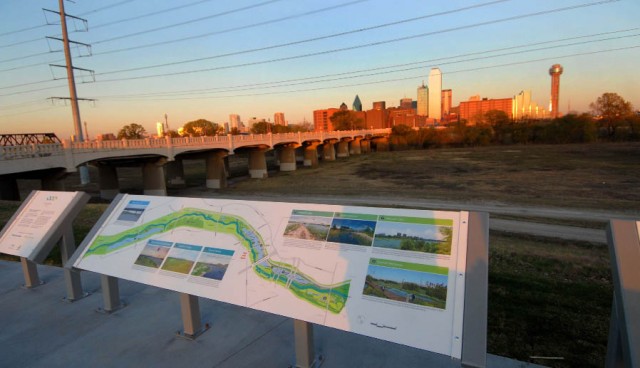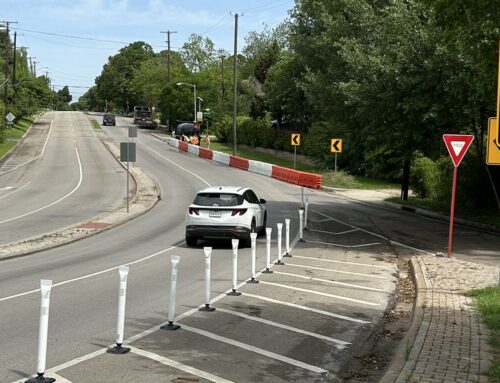The city’s series of neighborhood meetings on the new plan for the Trinity toll road from Mayor Mike Rawlings’ “dream team” made one of its last stops Monday night in Oak Cliff.
The plan is so inconsistent with reality, and so few questions were answered at the meeting, that I cannot pretend to present it to you, dear readers, as any sort of option for the future of Dallas. The Trinity toll road plan should die, and here are eight reasons why.
1. The “dream team” plan isn’t actually the plan at all.
Urban planner Larry Beasley said, via a speech for the Trinity Commons Foundation presented to neighbors by video, that the toll road would be built in a 10-year floodplain. In that case, the road would be underwater sometimes (including now, since we’ve just experienced a 10-year flood). But assistant city manager Mark McDaniel said the road actually would be built in a 25-, 50- or 100-year floodplain. What would that look like, and where are the plans for that? No one could answer.
Beasley’s plan for the Trinity River park and surrounding development also calls for Dallas County to “move the jails,” which would be great! Who wouldn’t like to move the Lew Sterrett Justice Center from the front of the Trinity River? However, Dallas County just opened a $50-million hospital inside the jail. Seems unlikely they’re just going to “move the jails.”
2. The dreamers’ new plan is, politely put, nothing more than an attempt at better public relations.
City Councilman Scott Griggs is fond of pointing out that “we were all sold on a bunch of pretty water colors” to buy into the first toll-road plan. That trend continues with this Beasley plan. The overall scheme still is to build a 6-to-8-lane tolled road between the levees; it’s just that Beasley’s plan calls for doing it in phases. Phase one would create the four-lane “meandering” tollway, leaving opportunities to build it out to double its size in a “future generation.” But the city doesn’t want us to think about that now. They want us to think about a “cute little road,” as Griggs calls it, and the lovely surrounding park. But the city still has a contract with the North Texas Tollway Authority for the proposed road. “They build toll roads; they don’t build cute little roads that are compatible with parks,” Griggs said. “This is just going to creep and become bigger and bigger.”
3. No one who benefits from building the road would be paying the tolls.
The Trinity toll road supposedly would serve to move workers in southern Dallas to jobs in northern Dallas. The Federal Highway Administration estimated that the road actually would cause more traffic. It is insulting that the city is asking workers in southern Dallas to get in their cars and drive to jobs 30 or 40 miles away in northern Dallas and pay a toll to the NTTA for the privilege. Instead of building a toll road, we should be creating incentives to draw high-paying jobs to southern Dallas. That way, people in those neighborhoods would have good jobs and shorter commutes and therefore higher quality of life.
4. It basically would tax people to use a public park.
Beasley said the focus of the Trinity toll road should be the proposed park between the levees and access to that park. But since it is a toll road, accessing the park would require payment to the NTTA. Beasley said the NTTA could enact “toll forgiveness” for park users. How would that work, exactly? No one could answer.
5. We don’t need it, from either an economic or traffic-reducing standpoint.
We are in a huge economic upswing. Why are the moneybags behind this unpopular and unnecessary road still so zealous about it when there are oodles of development opportunities out there? We don’t need to build a road for economic development. Economic development is happening, and the city freely hands out tax incentives for it.
Right now in Oak Cliff, there are efforts to reduce the sizes of our roadways so that our neighborhood won’t be a fly-through between the suburbs and northern Dallas. Tyler/Sylvan has been reduced from six lanes to four, and there is a plan to turn Tyler and Polk into two-way streets. The overall scheme for the toll road still calls for tearing down and rebuilding the Jefferson viaduct to massive proportions, which would destroy the neighborhood surrounding Burnett Field and Lake Cliff Park.
6. We can have parks and nice things without a road.
The dreamiest part of the Beasley plan is that it calls for five overlook points that would build connections to economic development. Consider the relationship between the Continental Bridge Park and Trinity Groves. It’s an area that draws the well-heeled of Highland Park to fancy restaurants, and it also serves families from La Bajada neighborhood with the bridge park, for example. The Beasley plan calls for four more similar park/overlook areas complementing development — near the Santa Fe Trestle trail, at the Reunion Tower area, at Turtle Creek and at Inwood. Why do we need a toll road to do that? Or, if you want to build a road someday, let’s start with those projects first and then decide if we really need a road.
7. The Army Corps of Engineers hasn’t approved it.
The Beasley plan offers photos of a beautiful, palm-tree lined roadway in Australia to show us what our first-phase, four-lane road could look like. Lots of big trees on both sides of the road. Lots of big trees and tiered landscaping throughout the park … in a floodplain. The Army Corps of Engineers approved the city’s plan for the original scheme of a six-to-eight-lane highway. But it has not approved the cute little meandering road with all those trees in the Beasley plan.
8. Global climate change is real.
Even though clandestine donors spend millions of dollars to fund climate-change deniers, it is science that our planet is getting warmer. The 1908 flood, which was the worst in Dallas history, was extremely devastating because the levees had not been built. But Dallas actually had more rain in April/May 2015 than in April/May 1908. Why would we invest our money to build an unnecessary road in a floodplain, amid global climate change?






